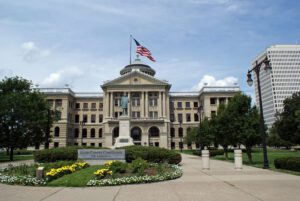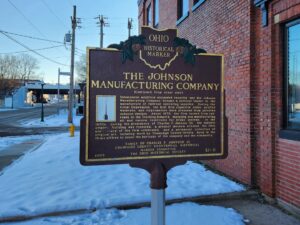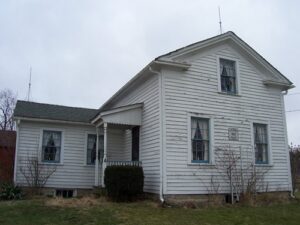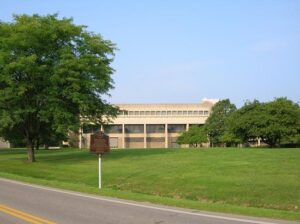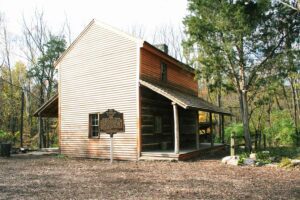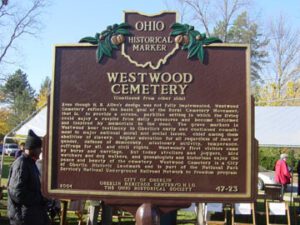, OH
Lucas County was named for Governor Robert Lucas who championed Ohio’s cause in the “Toledo War,” a boundary dispute arising when both Ohio and the Michigan Territory claimed this area. The Ohio legislature created Lucas County on June 20, 1835. The first court session convened in a Toledo schoolhouse during the pre-dawn hours of September 7 to avoid the Michigan militia.
, OH
The Johnson Manufacturing Company was incorporated in 1902 by brothers James B., J. Will, Isaac T., and Charles F. Johnson, all of Quaker heritage. The company manufactured tin and galvanized iron ware for railroad lines across the United States. The initial product was the No. 1 long-spouted locomotive oiler with the patented dripless spout. That was quickly followed by other types of oil cans, signaling equipment, engine buckets, tallow pots, torches, track inspection devices, tin cups, and caboose and cabin car lamps, all carrying the Diamond J trademark. The makers created the patterns and everything was cut, riveted, and soldered by hand. As production expanded, the original frame building at 605 Miami Street was replaced by a brick structure in 1910, the southernmost part of the present building. (continued on other side)
, OH
This 48-acre farm is the last remnant of an agricultural way of life that characterized Parma Township well into the 20th century. The farmhouse, built circa 1855 by Western Reserve settler Lyman Stearns, is representative of the Greek Revival style of architecture popular in this region prior to the Civil War. The “Yankee” style barn predates the house. Suburban development following World War II engulfed virtually all of this area by the 1950s. The Stearns Homestead was added to the National Register of Historic Places in 1981. (continued on other side)
, OH
Wilberforce University, founded at Tawawa Springs in 1856 by the Methodist Episcopal Church, is the first private historically black college or university in America. The inspirations for Wilberforce were an unwavering faith in God, an acknowledgement of the contribution of the British abolitionist and Member of Parliament William Wilberforce, the leadership of AME Bishop Daniel Payne, and the belief in the potential of all women and men to learn and prosper. Wilberforce embraces the love of learning and the use of education as a tool of personal and community empowerment. Wilberforce seeks to cultivate and meet the historic hunger for freedom and liberty of all people. Today, Wilberforce is affiliated with the African Methodist Episcopal Church and educates diverse students from across the nation and around the world. Wilberforce continues to serve as a beacon for learning and research.
, OH
The 1804 Iddings House is the oldest structure on its original site in Miami County. A second generation American and cousin to General “Mad” Anthony Wayne, Benjamin Iddings brought his wife, Phoebe, and six of their ten children up the Stillwater River into Newton Township and constructed the log house in 1804. In 1976 the structure was placed on the National Register of Historic Places with an initial restoration in 1981. Thanks to community support, further restoration was completed in 2006.
, OH
The Peoples Bank Theatre, built in 1919 and called the Hippodrome, marks an age when movies transitioned from silent films and nickelodeons into a major national industry and pastime. Designed by Columbus architect Fred Elliott for the C&M (Cambridge and Marietta) Amusement Company, the theatre featured a granite archway, 1,200 seats, a 35-by-55-foot stage, an orchestra pit, and the first air conditioning of its kind in Marietta. The Hippodrome opened May 9, 1919 with the silent film Daddy Long Legs, starring Mary Pickford. Shea Theatres of New York bought the Hippodrome and remodeled it in 1949, replacing the Hippodrome’s distinctive stone archway with a two-story southern colonial-style facade. Renamed the “Colony,” it opened June 25, 1949, showing the Esther Williams’ musical Neptune’s Daughter. (Continued on other side)
, OH
Industrialist and entrepreneur Franklin Augustus Seiberling (1859-1955) named his fledgling rubber goods manufacturing company “Goodyear” to honor Charles Goodyear, the man who invented the vulcanization process for curing rubber. Seiberling founded the company with his brother, Charles Willard, because of their desire to participate in an enterprise that afforded an “opportunity for invention.” Incorporated in 1898, Goodyear Tire and Rubber Company rapidly grew with the young automotive industry and helped establish Akron as the “Rubber Capital of the World.” Among Seiberling’s many significant inventions were the tire-making machine and the detachable wheel rim. He resigned from Goodyear in 1921 and went on to found the Seiberling Rubber Company. Stan Hywet Hall, F.A. Seiberling’s estate in west Akron, is a National Historic Landmark.
, OH
Shortly after Oberlin Colony was established in 1833, a two-acre burying ground was set aside south of Plum Creek in the area bounded by Main, Morgan, and Professor streets. By 1861, however, with the town and Oberlin College growing and the Civil War escalating, the need for a larger cemetery became clear. After an extensive search, 27.5 acres of land belonging to Henry Safford were acquired one mile west of the center of Oberlin. H.B. Allen was hired to create a design in the style of the Rural Cemetery Movement, and in July 1864 Westwood Cemetery was formally dedicated. Burials in Westwood had actually begun in August 1863, and over the next few years hundreds of remains were reinterred from Oberlin’s “Old Cemetery” and from burying grounds in surrounding communities. In the mid-1860s the cemetery was enlarged to its present 47 acres, and in 2004 burials and memorials were estimated to number almost ten thousand. (Continued on other side)


